



Five scyllarine lobster species, belonging to the family Scyllaridae, are described from Korean waters: Chelarctus cultrifer (Ortmann, 1897), Crenarctus bicuspidatus (De Man, 1905), Galearctus kitanoviriosus (Harada, 1962), G. timidus (Holthuis, 1960), and Petrarctus brevicornis (Holthuis, 1946). Of these, three species, C. bicuspidatus, G. timidus, and P. brevicornis are new to Korean marine carcinological fauna. This report extends the known range of G. timidus to the southern coast of Korea from Taiwan in the East China Sea. Excluding C. bicuspidatus and G. kitanoviriosus, the other three species are relatively rare in Korean waters. They are described herein with color photographs, and a key to the Korean genera and species of Scyllarinae is also presented.
Recently Holthuis (2002), who revised the Indo-West Pacific scyllarine lobsters, established 13 new genera formerly placed in the genus
During a study of the decapod fauna of Korea, five locust lobsters,
The specimens examined in this study were deposited in the National Fisheries Research and Development Institute (NFRDI). After capture, samples of
Carapace length (CL), which is measured from the anterior margin of the rostrum to the posterior mid-dorsal margin of the carapace, is used to indicate the size of the specimens. The terminology used within descriptions follows that of Holthuis (1991). Genera and species are arranged in alphabetical order.
Order Decapoda Latreille, 1802
Family Scyllaridae Latreille, 1825
Subfamily Scyllarinae Latreille, 1825
Genus Chelarctus Holthuis, 2002
1*
Material examined. Korea: Busan: 1♀ (CL 29.8 mm), Haeundae, Mipo, trap, 14 May 2001, Kim MH; 1 ovig. ♀ (CL 29.2 mm), Haeundae, Mipo, trap, 20 Sep 2001, Kim MH.
Description. Carapace (Fig. 1A, B) with anterior postrostral carina bearing sharp rostral and well developed gastric teeth, but no pregastric tooth; posterior postrostral carina with 2
distinct flattened submedian tubercles replacing cardiac tooth; more than 10 flattened tubercles, each on anterior and posterior postrostral carinae; anterior branchial carina ending anteriorly in 2 sharp teeth and bearing several indistinct tubercles posteriorly; posterior branchial carina ending anteriorly in tooth and bearing 2 or 3 rows of more than 20 tubercles; anterior submedian carina with 2 large, and further small tubercles; posterior submedian carina with patch of irregular tubercles; intermediate row consisting of 5 tubercles; lateral margin with 5 or 6 inconspicuous anterolateral teeth, excluding anterior acute tooth, with 3 or 4 inconspicuous mediolateral teeth, with 9 or 10 posterolateral teeth; postorbital tubercle present; intercervical carina consisting of irregular group of 4 or 5 tubercles. Abdomen (Fig. 1A, B) with arborescent sculpture consisting of numerous longitudinal grooves on each tergum and pleura, and with slightly elevated middorsal carina; first somite with complete transverse groove extending over its full width, each of second to sixth somites with transverse groove widely interrupted in middle; each of posterior margins of first to fourth somites with median incision; pleuron of first somite bilobed, each pleuron of second
to fourth somites pointed posteroventrally, that of fifth somite ending in blunt angle. Telson (Fig. 1A) with arborescent pattern of longitudinal grooves on hard part; posterior margin of hard part with 4 teeth, each bearing 1 or 2 additional teeth. Antennular somite (Fig. 1A) sinuous in anterior margin. Antenna (Fig. 1A, C) oval in general view; sixth segment with 5 teeth in distal margin and 1 or 2 teeth in inner margin; fifth segment with sharp tooth in distomedial angle; fourth segment with median carina, provided with 2 teeth in anterior margin, 3 teeth including apical tooth in lateral margin. First pereopod most robust, second pereopod longest among pereopods (Fig. 2A-E), each propodus and carpus with weak hairy groove, each merus with 2 distinct hairy grooves; third and fourth pereopods subchelate, their propodi and carpi flattened laterally and each with dorsal fringe of hairs, each of propodus to merus with 2 hairy grooves; fifth pereopod most slender, subchelate in female, propodus with 2 hairy grooves, carpus and merus with hairy groove, respectively. Anterior part of thoracic sternum (Fig. 1C) produced; anterior margin truncate with median fissure continuing as deep longitudinal groove.
Coloration. Body brownish and with anterior dorsal abdomen reddish; carapace with dark brown patches on carinae or tubercles; pereopods pale yellow and with purple bands; softpart of tail fan semi-transparent and grayish white (Fig. 11A).
Distribution. Indo-West Pacific: Korea, Japan, China, Taiwan, Philippines, Indonesia, eastern coast of Africa from Kenya to Mozambique, Madagascar and Hawaiian Islands; 18-300 m. In Korea, only coast of northern Busan, 20 m.
Remarks. The genus
1*Genus Crenarctus Holthuis, 2002
2*Crenarctus bicuspidatus (De Man, 1905) (Figs. 3,4,11B, C)
Material examined. Korea: Gyeongsangnam-do: 1♀ (CL 19.0 mm), Tongyeong, Hansan Island, shrimp trawl, Oct 1998, Choi JH; 3♂♂ (CL 13.1-14.9 mm), Tongyeong, Hansan Island, shrimp trawl, 13 Sep 1999, Choi JH; Busan: 1♀ (CL 23.2 mm), Haeundae, Mipo, trap, 5 Jul 1999, Kim MH; 1♀ (CL 20.0 mm), Haeundae, Mipo, trap, 14 May 2001, Kim MH; 1♀ (CL 23.5 mm), Haeundae, Mipo, trap, 16 Aug 2001, Kim MH; 1♂ (CL 18.2 mm), Haeundae, Mipo, trap, 5 Sep 2001, Kim MH; 2♂♂ (CL 14.9, 21.5 mm), 1♀ (CL 23.1 mm), Haeundae, Mipo, trap, 20 Sep 2001, Kim MH; 1♀ (CL 20.0 mm), Haeundae, Mipo, trap, 1 Dec 2001, Kim MH; Jejudo: 1♂ (CL 23.0 mm), 1 ovig. ♀ (CL 23.0 mm), Seoguipo, Mun Islet, SCUBA, 25 Oct 2002, Son MH.
Description. Carapace (Fig. 3A, B) with dorsal and lateral carinae covered with distinct squamiform tubercles; anterior postrostral carina bearing small rostral and large pregastric teeth, and pair of large tubercles replacing gastric tooth; posterior postrostral carina with cardiac tooth ending in 2 topped tubercles anteriorly; anterior branchial carina with 2 distinct teeth anteriorly; posterior branchial carina with blunt tooth anteriorly; anterior submedian carina with 2-7 low flattened tubercles; posterior submedian carina with group of 5-7 irregular tubercles; intermediate row consisting of 4 low tubercles; intercervical carina bearing patch of 1 large and 5-9 small tubercles; lateral margin with acute anterolateral tooth followed by 3 or 4 inconspicuous teeth, with 3 inconspicuous mediolateral teeth, with double row of 9 inconspicuous posterolateral teeth; postorbital tubercle present. Abdomen (Fig. 3 A, B) without mid-dorsal carina, having arborescent pattern of narrow and deep grooves; dorsal and lateral surfaces of first somite with complete transverse groove, each of dorsal and lateral surfaces of second to sixth somites with transverse crenulated groove, their median area forming elongate lobulated figure; each of posterior margins of first to fourth somites with deep median incision; pleuron of first somite short and bilobed, that of second somite with blunt apex,
those of third and fourth somites each with tip directed posteroventrally, that of fifth somite broadly rectangular or rounded; sixth somite and hard part of telson with squamiform tubercles, respectively; telson with 2 pairs of teeth on posterior margin of hard part. Antennular somite (Fig. 3A) with 4 rounded teeth. Antenna (Fig. 3A, C) somewhat rectangular in general view; sixth segment with 5 obtuse teeth in distal margin and 2 teeth in inner margin; fifth segment with sharp distomedial tooth bearing dorsal carina; fourth segment with prominent median carina, provided with 4 or 5 teeth in anterior margin, of these, second innermost tooth largest, 3 or 4 teeth including apical tooth in lateral margin, apical tooth occasionally with 2 additional teeth. First pereopod most robust and second pereopod longest among pereopods (Fig. 4A-E), each merus with 2 hairy grooves; third and fourth pereopods with propodi not flattened, each of propodus to merus of third pereopod and carpus and merus of fourth pereopod with dorsal fringe of hairs, their propodi and meri each with 2 hairy grooves, each carpus with 1 hairy groove; fifth pereopod most slender, subchelate in female, not subchelate in males, merus with 1 hairy groove. Anterior margin of thoracic sternum (Fig. 3C) emarginated, U-shaped, central part with deep median incision; median incision continued posteriorly as groove flanked by 2 ridges, these ridges ending behind anterolateral teeth in blunt tooth.
Coloration. Two types of color pattern of the animal present; one: body generally brownish orange; large black spot surrounded by wide pale ring on anterior half of first abdominal somite; sixth abdominal somite and hard part of tail fan brownish, soft part of tail fan yellowish pereopods pale yellow and with dark bands (Fig. 11B); another: ground color of body pale brownish purple; same large spot on anterior first abdominalsomite; proximolateral part of antenna, branchial area of carapace, and dorsolateral surface of abdomen exhibiting irregular patch of brownish black; soft part of tail fan more whitish; pereopods with same pattern (Fig. 11C).
Distribution. Indo-West Pacific: Korea, Japan, Indonesia, New Caledonia, Vietnam to Madagascar and South Africa; 2-108 m. In Korea, Busan, Tongyeong and Isl. Jeju.
Remarks. The genus
Cha et al. (2001) reported
1*Galearctus kitanoviriosus (Harada, 1962) (Figs. 5,6,11D)
Non
Material examined. Korea: Gyeongsangnam-do: 1♀ (CL 20.0 mm), Tongyeong, Hansan Island, shrimp trawl, 13 Sep 1999, Choi JH; Busan: 2♂♂ (CL 23.6, 24.9 mm), Haeundae, Mipo, trap, 16 Aug 2001.
Description. Carapace (Fig. 5A, B) with squamiform tubercles on dorsal and lateral carinae; anterior postrostral carina with sharply pointed rostral tooth and well developed gastric tooth, but pregastric tooth absent; posterior postrostral carina with cardiac tooth bearing 2 acute tips; anterior branchial carina with 2 sharp teeth anteriorly; posterior branchial carina with well-developed tooth anteriorly; anterior submedian carina with 2 large and further small flattened tubercles; posterior submedian carina with group of several flattened tubercles; intermediate row consisting of 5 small rounded tubercles; lateral margin ending in strong anterolateral tooth, followed by 2 tubercles, mediolateral area with sharp tooth anteriorly, followed by 3 tubercles, posterolateral margin with sharp anterior tooth, followed by 7 broad tubercles; postorbital tubercle present. Abdomen (Fig. 5A, B) without distinct mid-dorsal carina, having arborescent sculpture of deep and narrow grooves; dorsal and lateral surfaces of first somite with complete transverse groove, each of dorsal and lateral surfaces of second to sixth somites with transverse crenulated groove widely interrupted by elongate lobulated figure; each of posterior margins of first to fourth somites
with median incision, those of fifth and sixth somites somewhat convex in middle; pleuron of first somite small and bilobed, each pleuron of second to fourth somites ending in sharp tooth directed posteroventrally, those of fifth and sixth somites rounded ventrally; hard part of telson provided with 4 teeth posteriorly. Antennular somite (Fig. 5A) incised in middle, with 2 blunt lateral teeth. Antenna (Fig. 5A, C) with sixth segment slightly convex distally, bearing 5 cusp-like teeth in distal margin and 2 additional teeth in inner margin; fifth segment with 2 sharp teeth distally; fourth segment with sharp median carina, provided with strong tooth in anterior margin, 3 sharp teeth, including strong apical tooth in lateral margin, mesial margin with sharply pointed tooth near articulation with fifth segment. First pereopod more robust than other pereopods, second pereopod as long as third pereopod, fifth pereopod slightly slender (Fig. 6A-E), each of meri of all pereopods with longitudinal hairy groove; third pereopod with propodus flattened laterally, propodus and carpus bearing dorsal hairy fringes, respectively, propodus with 2 distinct hairy grooves; fifth pereopod with subchela in female, without subchela in males. Anterior margin of thoracic sternum (Fig. 5C) produced anteriorly, with small but distinct triangular median incision, it continuing posteriorly as median groove, triangular area around median groove sunken.
Coloration. Body generally dark brown; first abdominal somite with large circle median blackish spot surrounded by light ring; antennular segments with 2 dark bands, very small bright blue spot at base of antennulae; fourth antennal segment yellowish; two lighter transverse bands over carapace; second to fifth abdominal somites with light median spots, of these, that of second somite largest; sixth abdominal somite and hard part of tail fan whitish, soft part of tail fan light brown; pereopods pale yellow and with dark bands (Fig. 11D).
Distribution. West Pacific: Korea, Japan, Taiwan, New Caledonia, and Fiji Islands; 30-680 m. In Korea, Busan, Tongyeong and Jeju Island, 30 m.
Remarks. The genus
Cha et al. (2001) described
1*Galearctus timidus (Holthuis, 1960) (Figs. 7,8,11E)
Material examined. Korea: Gyeongsangnam-do: 1° (CL 20.2 mm), Geoje, South of Yokji Island, 34°28.3′N, 128° 28.9′E, otter trawl, 60-64 m, 24 Mar 2004.
Description. Carapace (Fig. 7A, B) with broad squamiform tubercles on dorsal and lateral carinae; anterior postrostral
carina with rostral tooth strong, gastric tooth huge and laterally compressed, no pregastric tooth; posterior postrostral carina with cardiac tooth as large as rostral tooth, consisting of 2 sharp triangular tubercles; anterior branchial carina with 2 strong teeth anteriorly; posterior branchial carina with sharply pointed tooth anteriorly; anterior submedian carina consisting of group of 3 large and 4 small flattened tubercles; posterior submedian carina with irregular group of 9 flattened tubercles; intermediate row consisting of 6 small tubercles; lateral margin with sharp and strong anterolateral tooth anteriorly, followed by 4 tubercles, mediolateral area with sharp tooth anteriorly followed by 4 inconspicuous tubercles, posterolateral margin ending in sharp tooth followed by 9 blunt tubercles; intercervical carina bearing 2 broad squamiform teeth; postorbital tubercle present. Abdomen (Fig. 7A, B) without distinct mid-dorsal carina but median area of second and third somites slightly elevated, having usual arborescent sculpturation in each tergum and pleuron; dorsal and lateral surfaces of first somite with complete transverse groove, those of second to fifth somites each with transverse crenulated groove slightly interrupted by median lobulated figure; each of posterior margins of first to third somites incised in middle; pleuron of first somite
short and bilobed, each pleuron of second to fourth somites sharply pointed posteroventrally, that of fifth somite with blunt angle ventrally; telson with 4 teeth on posterior margin of hard part. Antennular somite (Fig. 7A) incised in middle of anterior margin, with 2 blunt lateral teeth. Antenna (Fig. 7A, C) rather rounded square-shaped, sixth segment bearing 5 cusp-like teeth in distal margin and single tooth in inner margin; fifth segment with 2 sharp distal teeth; fourth segment with well developed median carina, anterior margin with 2 teeth in inner half, lateral margin with 3 sharp teeth including strong apical tooth, mesial margin with sharp tooth. First pereopod most robust among pereopods, second pereopod longest, fifth pereopod most slender (Fig. 8A-E); propodus of third pereopod widened, broader than those of other pereopods, with 2 longitudinal hairy grooves, propodus and carpus with dorsal fringe of hairs, respectively; propodus of fourth pereopod with short hairy groove; each carpus of third to fifth pereopods with hairy groove; each of meri of all pereopods with longitudinal hairy groove; fifth pereopod without subchela in male. Anterior part of thoracic sternum (Fig. 7C) produced forwardly, anterior margin with distinct triangular median incision, continuing posteriorly as median groove.
Coloration. Body generally brown, all carinae, teeth, and tubercles pigmented by reddish dark brown; first abdominal somite with large median orange spot surrounded by 3 white rings, lateral margin with white spot; sixth abdominal somite light with scattered brown spots; hard part of tail fan whitish with some brown spots; antennular segments with dark brown bands; pereopods yellow with reddish brown bands (Fig. 11E).
Distribution. Indo-West Pacific: Korea, Japan, Taiwan, Philippines, New Caledonia, Vanuatu, eastern Australia, Madagascar, and South Africa; 60-390 m. In Korea, Geoje, South of Yokji Island, 60-64 m.
Remarks. The present specimen is firstly reported as
1*Genus Petrarctus Holthuis, 2002
2*Petrarctus brevicornis (Holthuis, 1946) (Figs. 9,10,11F)
Material examined. Korea: Jeju-do: 1♀ (CL 17.0 mm), East of Jeju Island, 33°08.0′N, 127°00.7′E, otter trawl, 103-105 m, 5 Apr 2003; 2 ovig. ♀♀ (CL 13.2, 16.9 mm), Southeast of Jeju Island, 32°44.4′N, 127°07.6′E, otter trawl, 113 m, 22 Apr 2004; 1♀ (CL 16.9 mm), South of Jeju Island, 32° 24.6′N, 126°49.9′E, otter trawl, 115 m, 15 Mar 2005.
Description. Body (Fig. 9A-C) roughened by high tubercles and deep grooves. Rostrum (Fig. 10A) small, with broadly rounded tip. Carapace (Fig. 9A, B) very uneven; anterior postrostral carina with rostral tooth small, no pregastric tooth but low transverse ridge, gastric tooth not large, consisting of 3 tubercles; posterior postrostral carina with cardiac tooth large and high, followed by longitudinal rows of several small tubercles; anterior branchial carina very short, with 2 teeth anteriorly; posterior branchial carina with 2 longitudinal rows of 9 tubercles; anterior submedian carina reduced to single distinct tubercle; posterior submedian carina curved mesially with 4 tubercles; intermediate row consisting of 4 rounded tubercles; lateral margin with 4 anterolateral teeth, 4 mediolateral teeth, 10 irregular posterolateral teeth; intercervical carina with circular patch of 12 small tubercles. Abdomen (Fig. 9A, B) without arborescent sculpture, provided with distinct mid-dorsal carina on second to fifth somites, those of second and third somites each with median longitudinal groove and posterior median incision, those of fourth and fifth somites pointed posteriorly; transverse groove of dorsal and lateral surfaces of first somite absent, each of dorsal and lateral surfaces of second to fifth somites with broad deep hairy transverse groove; pleuron of first somite ending with 3 blunt teeth ventrally, each pluron of second to fourth somites with 2 tuberculate carinae over their full length, anterior carina ending in apex of pleuron, posterior carina ending in blunt tooth on posterior margin, anterior margin of second pleuron with 3 blunt lobes, that of third pleuron with blunt tooth, that of fourth pleuron smooth without tooth; sixth somite and firm part of telson with some irregular rows of tubercles dorsally, respectively; telson with 4 teeth on posterior margin of firm part. Antennular somite (Fig. 9A) with
longitudinal dorsomedian groove, anterior margin with 2 blunt lateral teeth. Antenna (Fig. 9A, C) with sixth segment relatively short and wide, bearing 7 slender sharp teeth in distal margin and small tooth in inner margin; fifth segment with 2 acute distal teeth; fourth segment with tuberculate median carina, anterior margin with 1 large and 3 small teeth, lateral margin with 4 sharp teeth including strong apical tooth, mesial margin with blunt tooth. Pereopods (Fig. 10A-E) no longitudinal hairy groove, but hairy fringe on meri of first and second pereopods, dactyli to meri of third to fifth pereopods in females. Thoracic sternum (Fig. 9C) provided with anterolateral teeth produced forwardly, anterior margin with small U-shaped incision flanked with small tubercle at each side.
Coloration. Body brown; anterior to cervical groove and branchiocardiac region whitish; anterodorsal half of first abdominal somite bright blue; terga of third to sixth abdominal somites with irregular white patches; pleura of fourth to sixth somites and tail fan whitish (Fig. 11F).
Distribution. Indo-West Pacific: Korea, Japan, Taiwan, East and South China seas, Philippines, New Caledonia, Zanzibar and Madagascar; 53-282 m. In Korea, only South and East of Jeju Island, 103-115 m.
Remarks. The genus
Key to Korean genera and species of Scyllarinae
1. Abdominal somites with distinct mid-dorsal carina sharply set off from rest of dorsal surface (Fig. 9A); posterior half of dorsal surface of second to fourth abdominal somites with rather wide transverse groove over the middle, but without arborescent sculpture of narrow grooves (Fig. 9A) ???????????????????????????????????????????
- Abdominal somites without distinct mid-dorsal carina sharply set off from rest of dorsal surface (Fig. 1A); posterior half of dorsal surface of second to fourth abdominal
somites with arborescent sculpture of narrow central groove with side grooves, which often branched (Fig. 1A) ?????? 2
2. Propodus of third pereopod with distinct distal tooth in ventral margin, forming kind of subchela with dactylus (Fig. 2C) ????????????????????????????????
- Propodus of third pereopod lacking distinct distoventral tooth, so not subchelate (Fig. 4C) ??????????????????????????????? 3
3. Pleura of second to fourth abdominal somites with blunt or rectangularly rounded apex (Fig. 3B) ????????????????????????? ????????????????????????????????????????
- Pleura of second to fourth abdominal somites ending in sharp posteriorly directed point (Fig. 5B) ??????????????????????? ???????????????????????????????????????????????????????????????
4. Gastric tooth of carapace very high, its anterior height distinctly more than half of distance between anterior base of gastric tooth and top of rostral tooth (Fig. 7B) ?????????????????????????????????????????????????????????????????????????????????????
- Gastric tooth not conspicuously higher than other teeth on postrostral carina, its anterior height much less than half of distance between anterior base of gastric tooth and top of rostral tooth (Fig. 6B) ????????
Korean name: 1*?????????
Korean name: 1*????????? (???), 2*???????? (???)
Korean name: 1*??????????
Korean name: 1*?????????? (???)
Korean name: 1*????????? (???), 2*???????? (???)
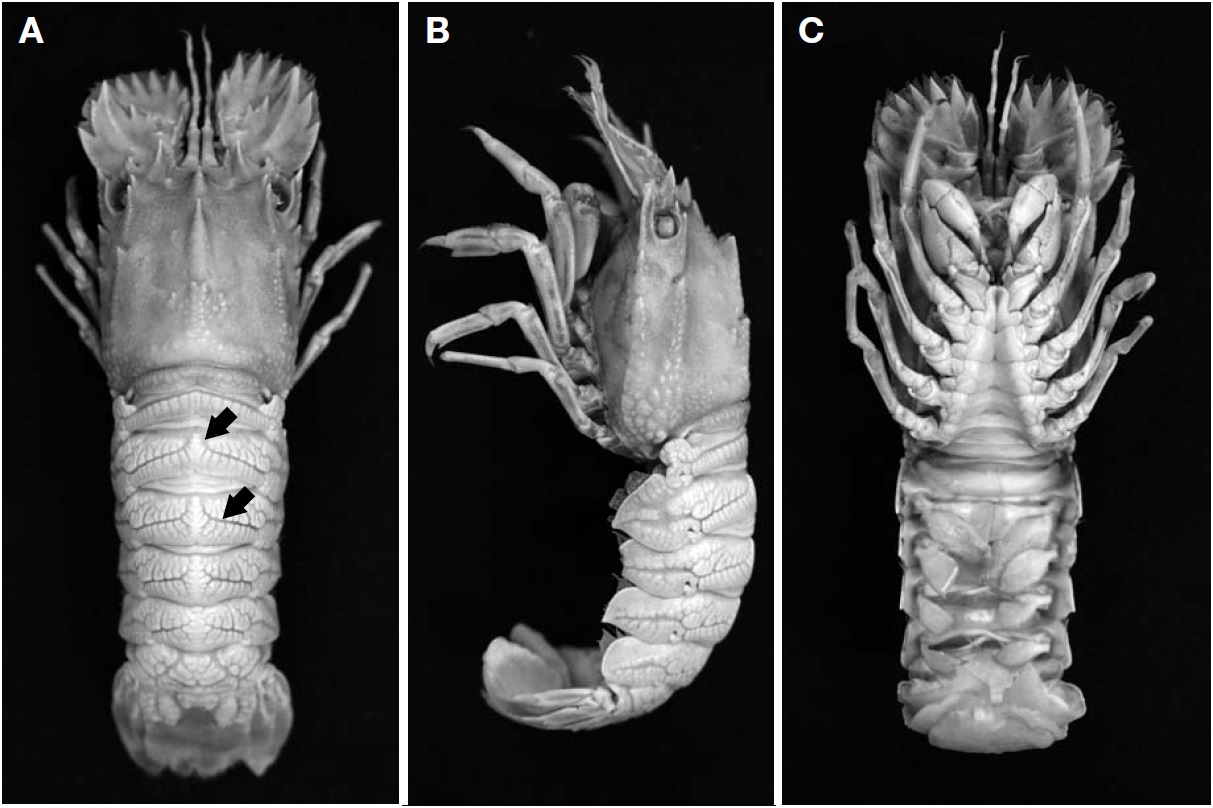
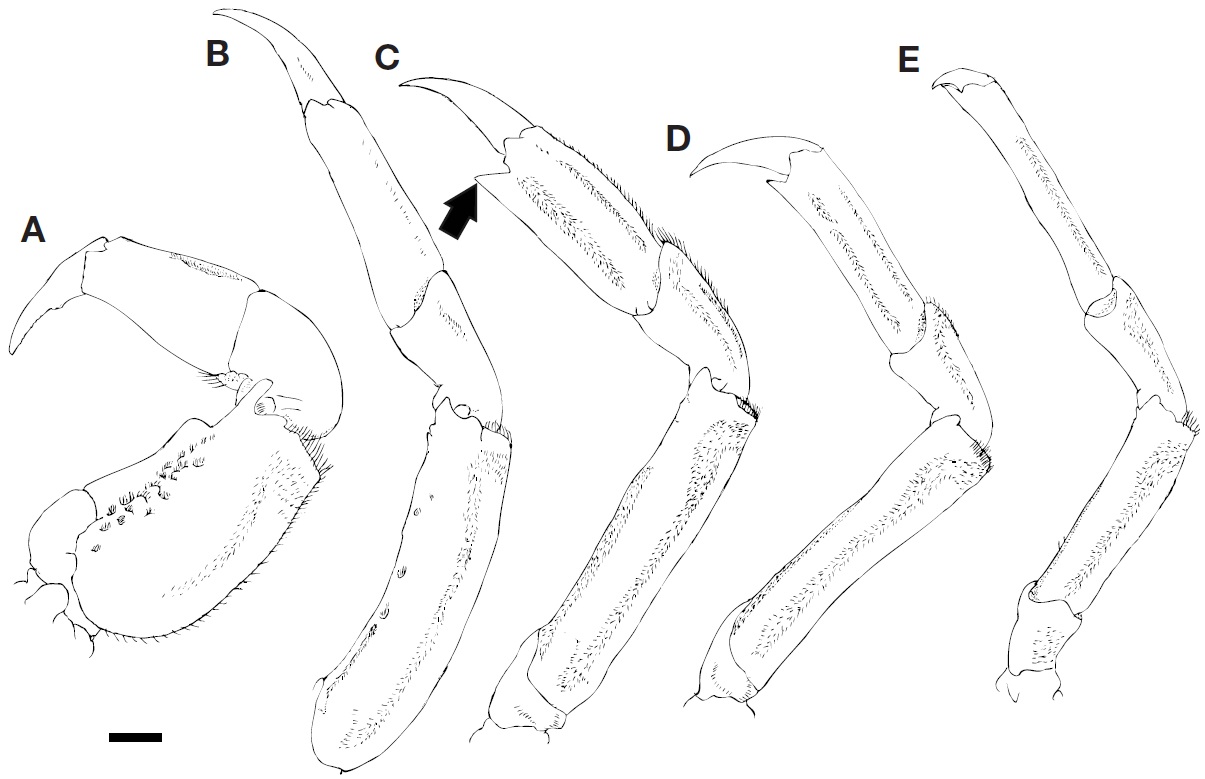
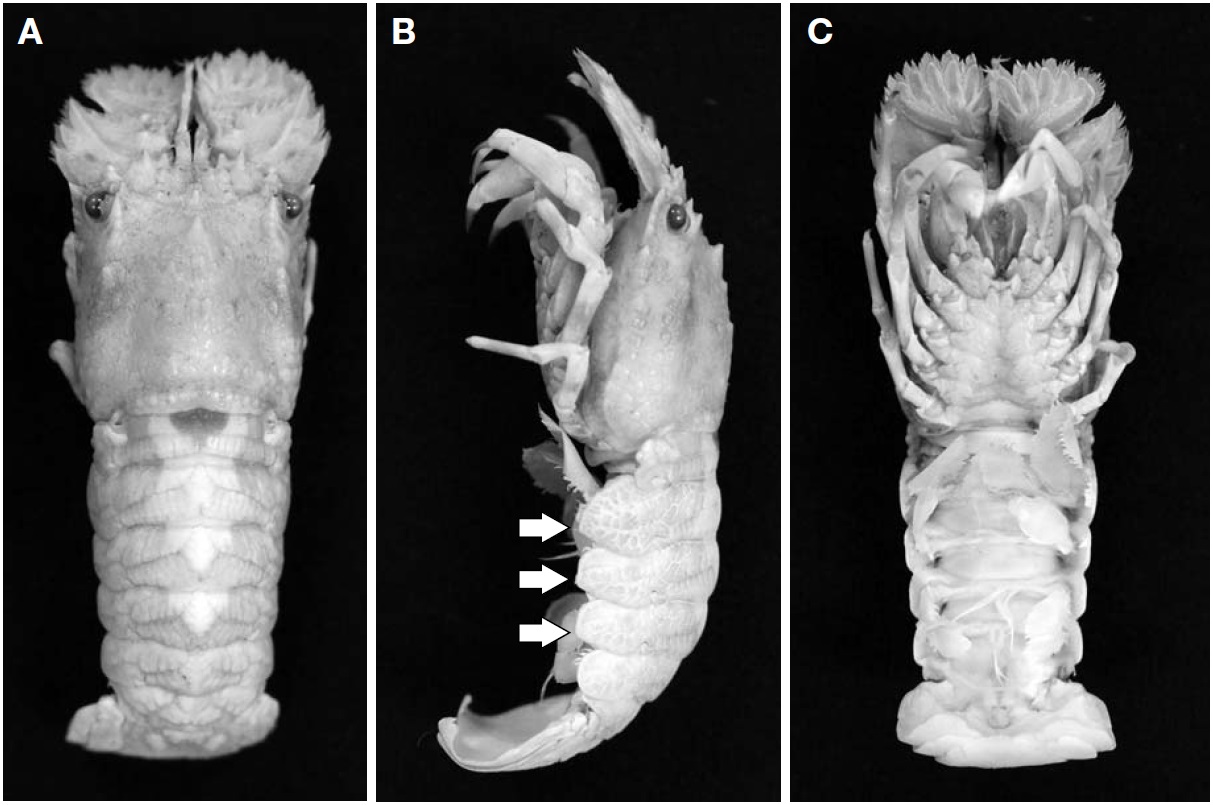
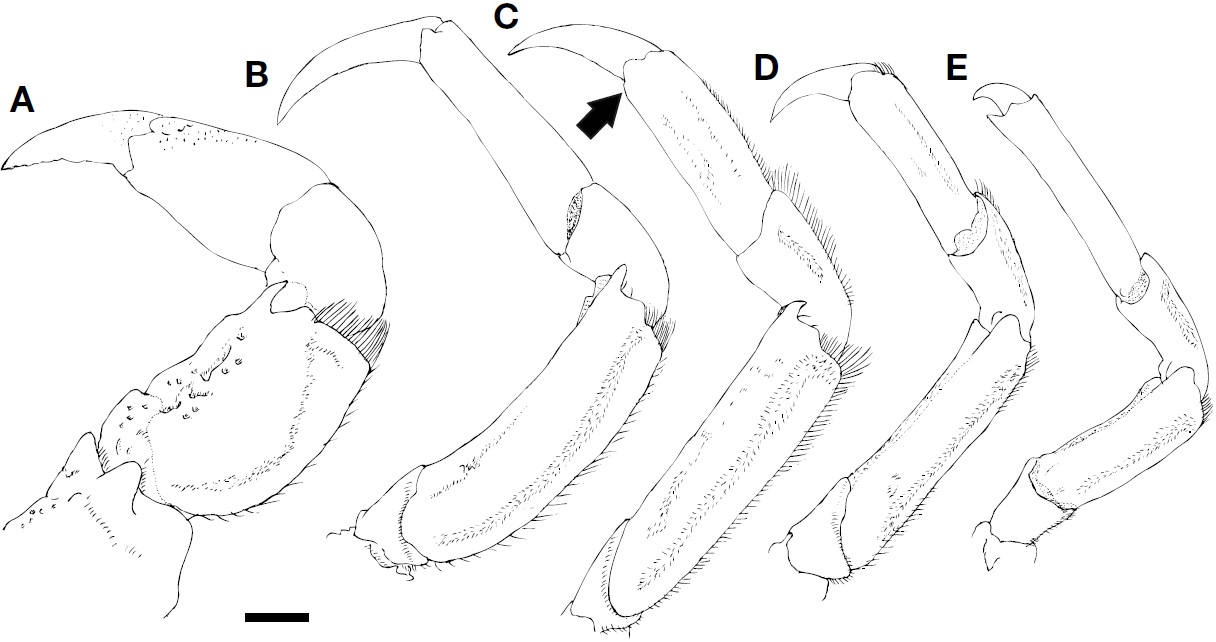
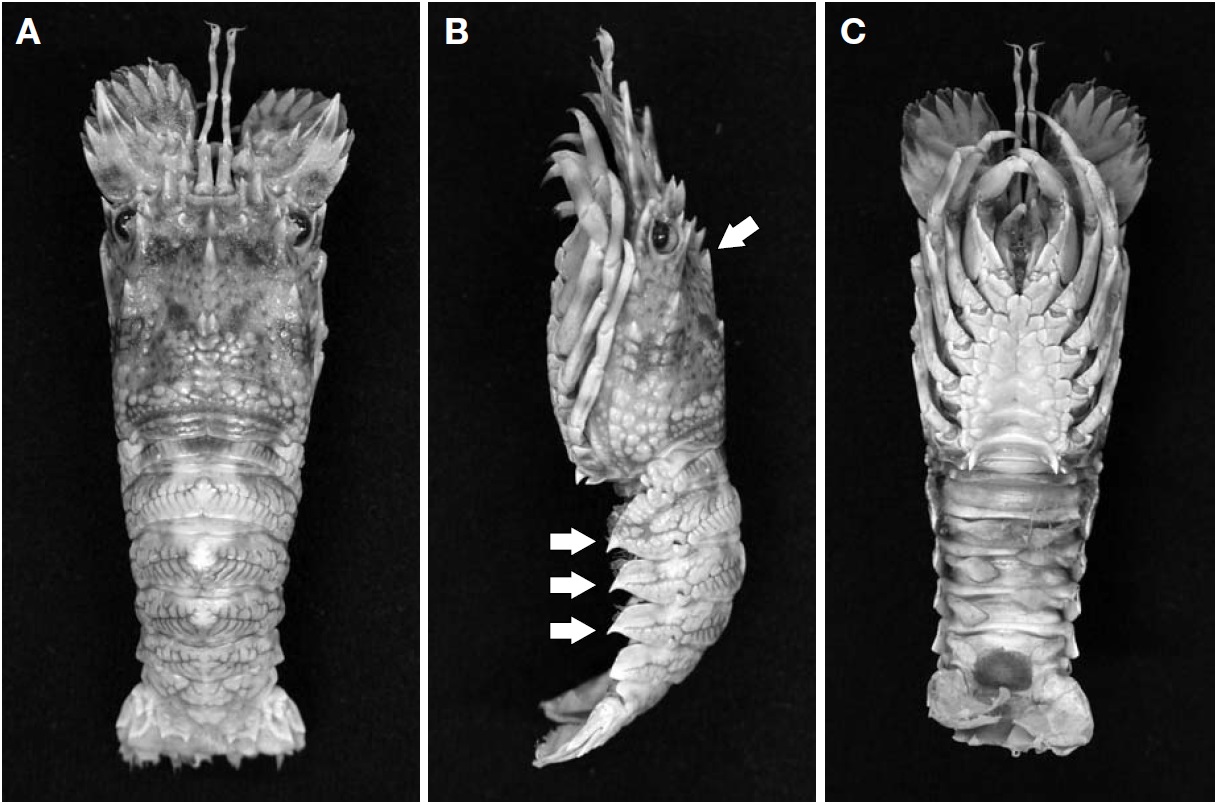
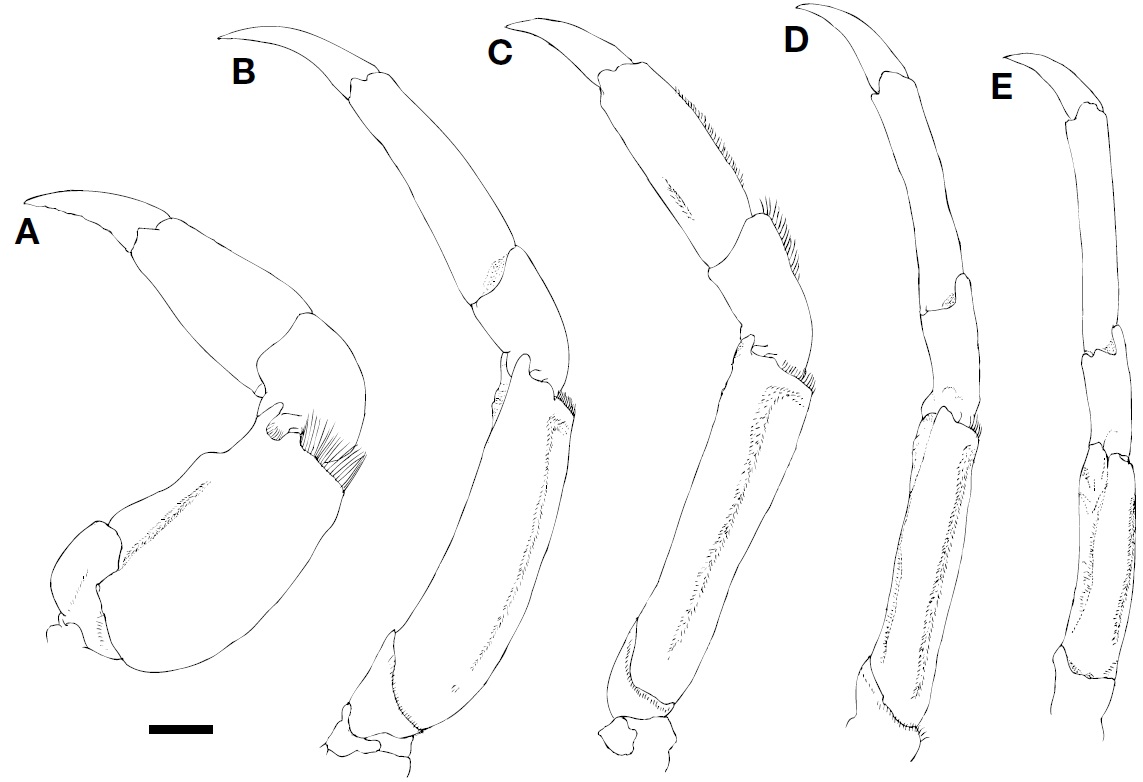
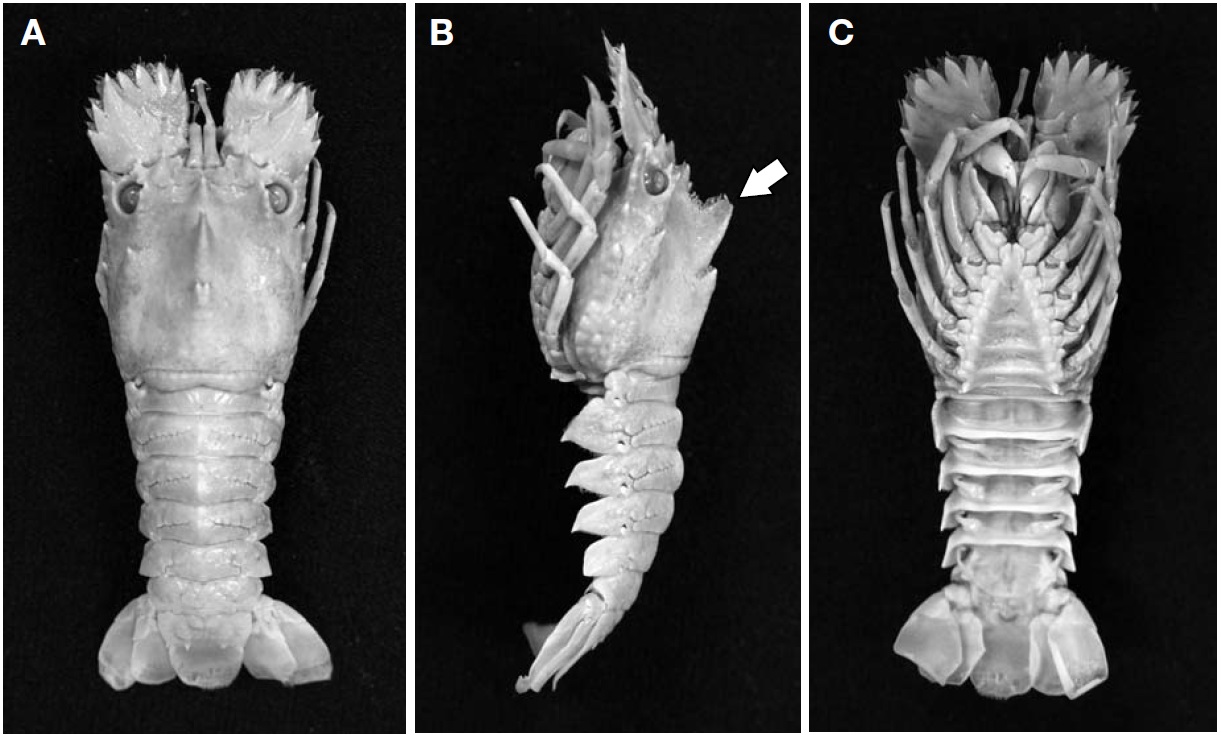
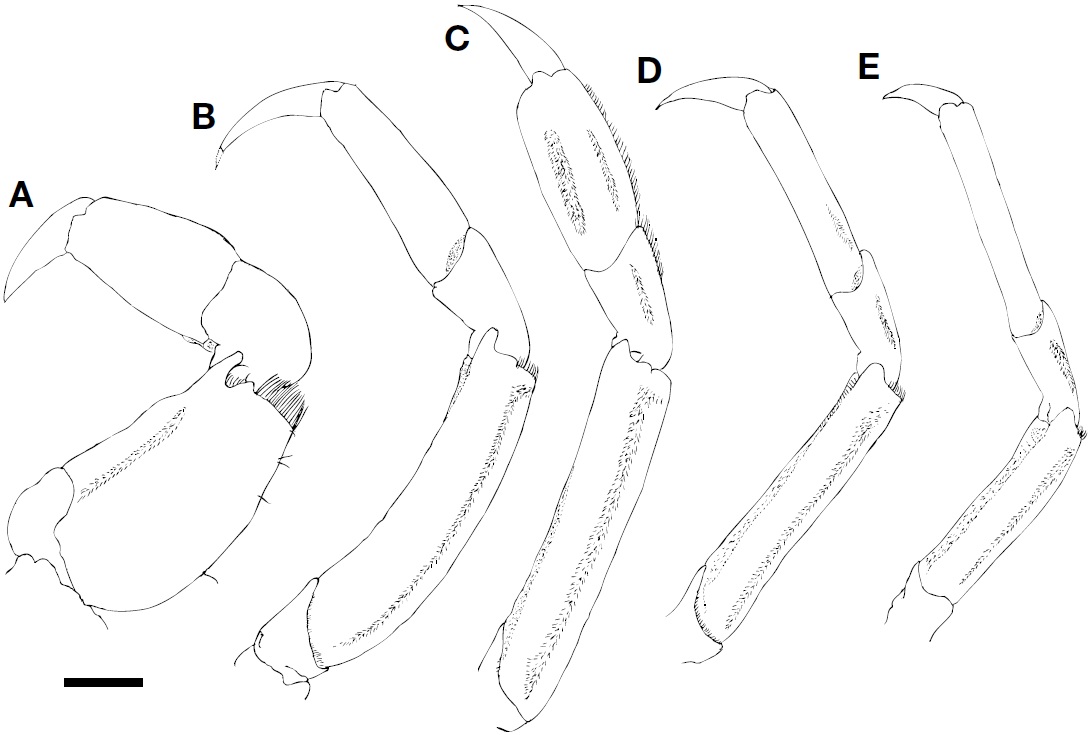
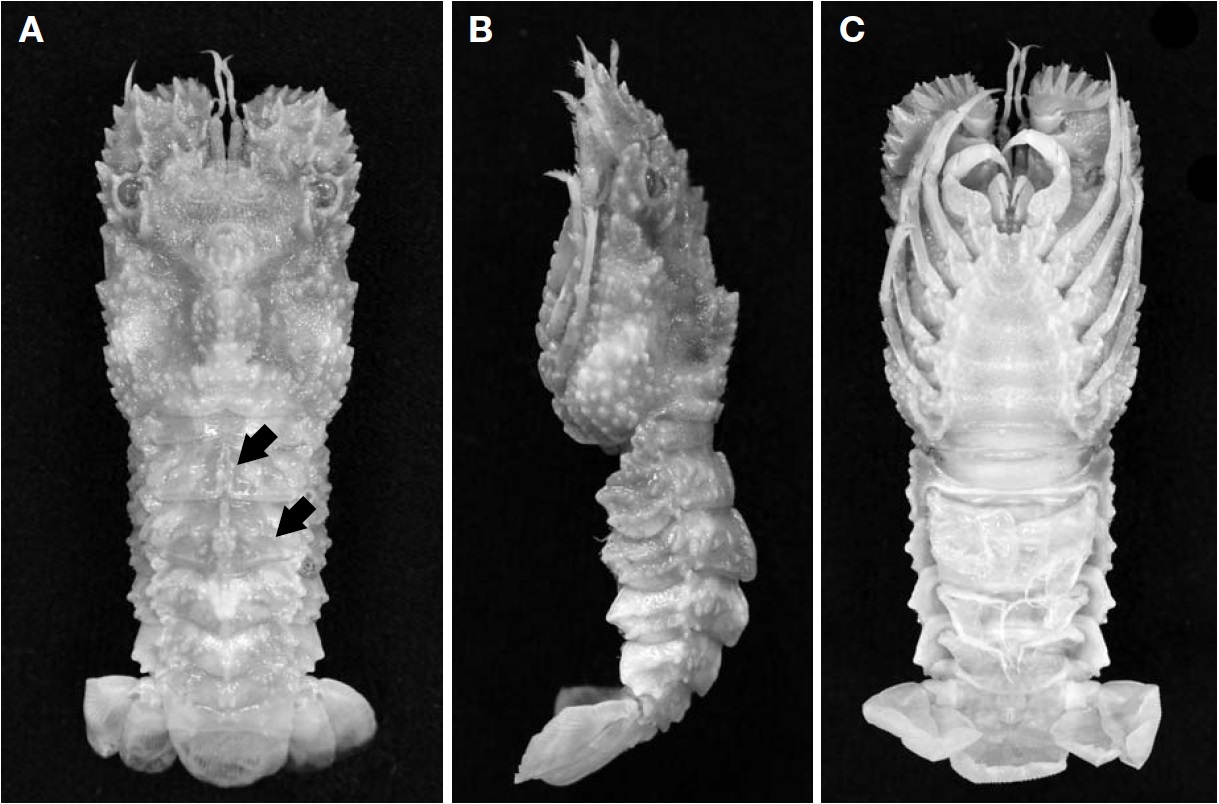
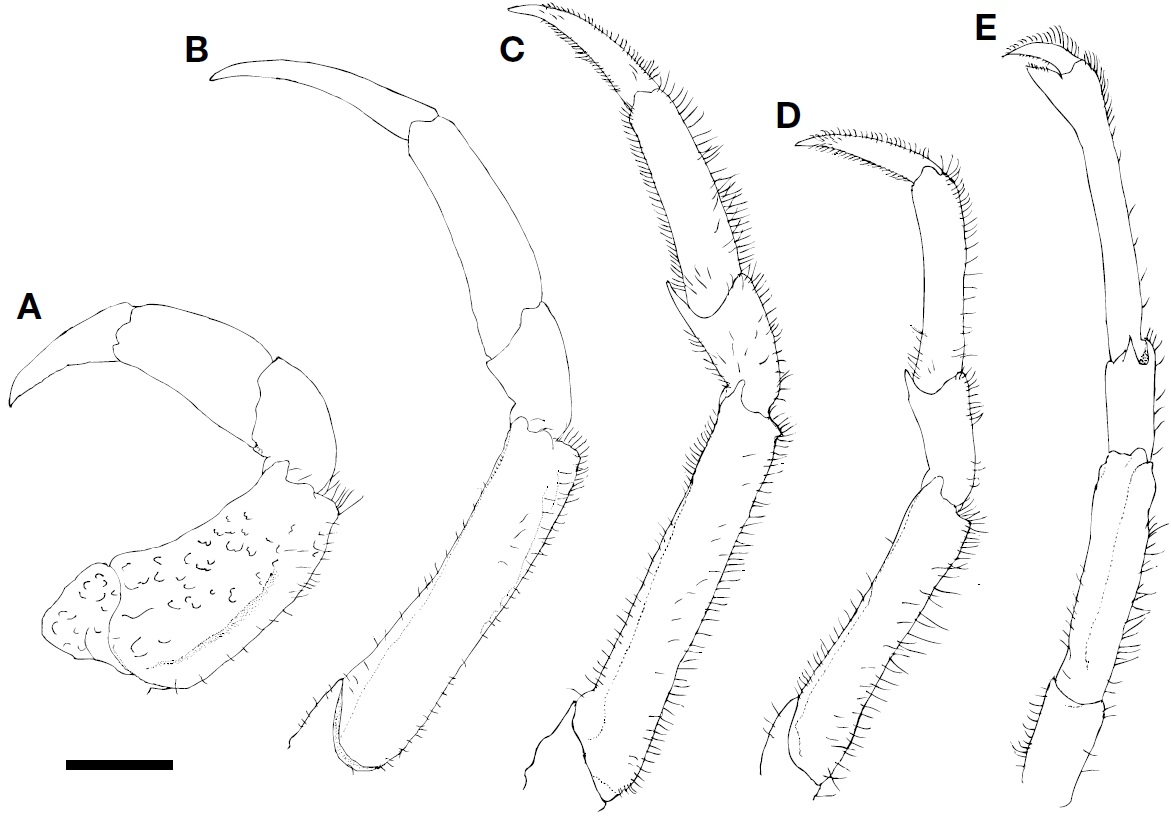
![A, Chelarctus cultrifer (Ortmann, 1897) from Busan (ovigerous female, carapace length [CL] 29.2 mm); B, Crenarctus bicuspidatus (De Man, 1905) from Busan (female, CL 23.5 mm); C, Same from Jeju Island (ovigerous female, CL 23.0 mm); D, Galearctus kitanoviriosus (Harada, 1962) from Busan (male, CL 23.6 mm); E, Galearctus timidus (Holthuis, 1960) from Yokji Island (male, CL 20.2 mm); F, Petrarctus brevicornis (Holthuis, 1946) from Jeju Island (female, CL 17.0 mm).](http://oak.go.kr/repository/journal/12127/DMBRBT_2013_v29n2_115_f011.jpg)